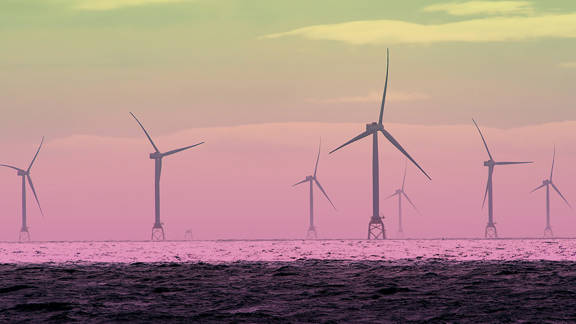Scotland at the forefront of the Fifth Industrial Revolution
24 Sep 2021 • 7 minute read

Wind, sea and the right chemistry... why Scotland is poised to play a significant role in Europe's sustainable energy production to help tackle climate change. Paul O’Brien, Scotland’s leading DeepWind cluster expert, shares his insight.
Written by Paul O'Brien opens in a new window
Somebody forgot to tell Scotland that it’s just a small country on the edge of Europe. It just never got that memo (or should that be email?). Instead, Scotland has always punched above its weight. Take any field of human endeavour you care to name, and you will likely find a significant Scottish contributor, if not a household name.
My personal heroes were always James Watt and James Young. They were not only engineers, chemists and inventors but they were also entrepreneurs who created companies to deliver their inventions to the market. They were the Elon Musk and Jeff Bezos of their day. Watt’s condensing steam engine and Young’s method to produce paraffin at industrial scale changed the world. They were two names who were part of a small band of global innovators who led us into the Industrial Revolution. Although they did not know it then, they also set us on a road to a car crash with climate change.

Paul O'Brien, DeepWind cluster expert
Too small to make a difference?
"We are too small to matter in the global scheme of things when it comes to climate change". I used to hear this line of argument from people who opposed actions on reducing carbon output in Scotland because we are not a large enough economy to make a serious dent in global emissions. Not only does this argument play down the role Scotland has played in developing the modern world, but it is born of ignorance of our future role in the Fifth Industrial Revolution.
Most people are aware of what is called the Fourth Industrial Revolution which is still evolving at the moment and builds on the foundations of the third – or digital – revolution. But what is meant by the fifth?
I would define the Fifth Industrial Revolution as the move to sustainable energy production and the replacement of fossil fuel-based chemistry with renewable feedstock-based chemistry.
Timeline of industrial revolution

Mechanisation
18th and early 19th centuries
Steam power replaces horse power and enables new labour saving production methods.

Electrification
Late 19th to mid-20th centuries
Mass production of machines and goods powered by electricity.

Automation
Late 20th century
Production utilising electronic and IT systems.

Digitalisation
Early 21st century
High-value manufacturing and integrated services utilising robotics, machine intelligence and Internet of Things, along with AR and VR.

Decarbonisation
Now until mid-21st century
Replacement of fossil-based fuels and chemistry enabled by renewable energy, hydrogen and CO2 direct air capture.
Today the fossil fuel industry relies on oil and gas recovered from onshore reservoirs, in such places as the Middle East, and offshore basins like the North Sea. They take this fossil based raw material, such as crude oil, which is made up of a mixture of hydrocarbons and separate them into hundreds of useful products with the main ones being the fuels – petrol, diesel, jet fuel, heating oils and heavier fuel oils.
Other fractions, about 11% of the total, form the basis of the petrochemicals industry and these long chain molecules or polymers are used to produce products such as polythene and other common plastics.
As we replace the need for fossil fuels with renewable based electricity, hydrogen and other sustainable fuels, the petrochemicals industry may struggle to remain commercially viable as they are a by-product of the oil and gas industry.
Can we live without these products?
Many would say yes, if we are talking about plastic bags and polythene wrapping, but the other petrochemical products are ubiquitous in our modern world. From the plumbing in your house (PVC), your toothbrush bristles (nylon), the milk container in your fridge (HDPE) to the case of your mobile phone (polycarbonate) they are the ‘invisible’ products of the oil and gas industry.
To successfully replace fossil fuels, we also need to look at how we replace the products of the petrochemical industry. That’s where the next industrial revolution comes in.
Net zero targets have set us on the path to this revolution and it will not be without its challenges as we switch one 120-year-old paradigm over to a completely new model. This new model requires huge amounts of renewable power from wind and solar sources, but that’s the easy part. The hard part is the chemistry. Manufacturing chemicals, particularly long chain hydrocarbon molecules, from their building blocks will be difficult, but we can start with the easy ones, like ammonia and methanol.
Why Scotland will help drive the Fifth Industrial Revolution
Over the last couple of years there has been a meteoric rise in the idea that hydrogen is the solution to the hard to decarbonise areas of our economies, namely transport, heat and industry. This is an idea that is not without controversy as other technologies could tackle each of these areas more efficiently, for example, heat pumps for the heat sector.
It is hydrogen’s role as an energy carrier and storage solution for all these areas which, I think, will lead to its adoption as the most holistic solution that can answer the issue of scale along with the utilisation of existing infrastructure. But….and it’s a big but, we need to show that it can deliver at the right cost.
Scale is the answer.
This is where Scotland can come to the party. We have one of the largest offshore Renewable Energy Zones in Europe married to a significant wind resource and, to steal a line from Carlsberg, can become probably the best green hydrogen producer in the world.
Scotland is already in the throes of delivering 10.5GW of offshore wind with a further 25GW planned for the current ScotWind 1 leasing round. Industry appetite for developing offshore wind in Scotland has resulted in 17 new sites in this ScotWind round. The list of successful applicants is a who’s who of the global wind industry including oil supermajors BP, Shell and TotalEnergies.
The Scottish Government is already planning a further round, the Innovation and Targeted Oil and Gas or INTOG, with the aim of decarbonising the oil and gas production energy on platforms and other infrastructure in the North Sea. This is estimated to add a further 4GW of floating wind to the already world beating 15GW of floating in the ScotWind 1 round. Scotland is currently the world leader in the deployment of floating wind and the 11 commercial scale projects in this ScotWind round will set the scene for a huge expansion of floating wind in Scottish waters.
A future global exporter of green hydrogen
This is the key to Scotland becoming a major producer and exporter of green hydrogen as our deeper waters require this floating technology to harvest this resource. Although still an emerging technology today, Scotland will be at the forefront of the drive to cost reduction in floating wind.
Our DeepWind offshore wind cluster is the leading UK cluster for floating wind. And, with over 600 supply chain companies, it’s members can drive cost reduction through the development of new innovative products and services. Industry can gear up for the challenge, but this will require government support in the initial stages. But, as already shown in fixed bottom wind, rapid cost reduction can be achieved by innovation and deployment at scale.
At the same time, we need to scale up the production of green hydrogen. This will involve a more entrepreneurial approach by the Scottish and UK governments, to remain ahead of the curve. They need to start planning now for a leasing and licensing round that would allow much larger floating offshore wind projects of scale to come forward. To reach the economies of scale required, we need to be looking at project sizes in the 5-10GW range which is also enabled by individual turbine sizes of 15-18MW being available in the next few years.
Scotland’s huge offshore Exclusive Economic Zone (EEZ) makes us one of the few countries in Europe that could host multiple projects of such scale and offers the vision of an offshore wind-to-hydrogen industry which would rival oil and gas in its heyday.
Scotland would not only be a major exporter of hydrogen to the rest of the UK and Northern Europe but will also become home to a new generation of green chemical facilities utilising the building blocks of hydrogen, captured carbon dioxide and nitrogen to manufacture a host of sustainable chemical products. This new chemistry will require innovative methods of synthesising the polymers and plastics that are so much part of this modern world. Renewable hydrocarbons need to play their part on the road to net zero.
That’s the Fifth Industrial Revolution and we can start it right here, in Scotland, with the right mix of government vision and industry ambition, which we can then export to the world. That will be our contribution to tackling climate change, and there is nothing small about it.
You might also be interested in
-
Offshore wind industry in Scotland
Scotland's energy expertise, engineering heritage and location make us the natural choice for offshore wind projects
-
Offshore wind supply chain
Scotland has over 9,000 wind energy supply chain businesses, including some of the best, most inventive firms in the world.
-
Hydrogen energy future
Could hydrogen be key to Scotland achieving net zero? Scotland's hydrogen, energy and low carbon specialists, Dave Holman and Meinolf Otto share their thoughts.
Need help?
Want to get involved in offshore wind projects in Scotland? Let’s work together. Talk with our experts to get started.
